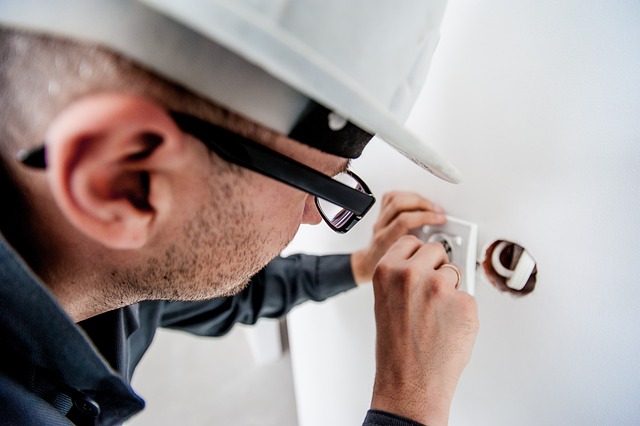Electricians troubleshoot diverse malfunctions, from flickering lights to complex circuit issues, using their expertise and well-equipped toolkits. Prioritizing safety through de-energization and protective gear is vital. Regular maintenance, including toolkit upkeep and following diagnostic steps like checking symptoms, wiring damage, and using test equipment, prevents costly breakdowns. Homeowners can minimize future problems with quick fixes, preventative measures, regular inspections, and qualified electrician checks.
Troubleshooting and fixing electrical malfunctions is a key skill for any qualified electrician. Whether it’s a flickering light, a circuit breaker tripping, or a power outage, understanding common issues and following safe practices is vital. This article equips you with the knowledge to navigate these challenges. We explore common electrical malfunctions, provide essential safety precautions, offer a detailed step-by-step diagnosis guide, and share effective fixes along with preventative measures to keep your circuits running smoothly.
- Understanding Common Electrical Malfunctions
- Tools and Safety Precautions for Electricians
- Diagnosing the Issue: Step-by-Step Guide
- Effective Fixes and Preventative Measures
Understanding Common Electrical Malfunctions

Electricians often encounter a range of electrical malfunctions, each requiring specific troubleshooting techniques. Understanding common issues is half the battle won. From flickering lights to circuit breakers tripping, these problems can vary widely in complexity. A simple reset might fix minor glitches, while more severe cases may demand meticulous diagnostics to identify the root cause.
By familiarizing themselves with these malfunctions, electricians can efficiently navigate repairs. Regular maintenance and quick action when issues arise are key to preventing larger, costlier problems. Moreover, recognizing patterns in recurring faults allows professionals to offer tailored solutions, ensuring customer satisfaction and safety.
Tools and Safety Precautions for Electricians

Electrians require a well-equipped toolkit to effectively troubleshoot and fix electrical malfunctions. Essential tools include voltage testers, pliers, wire strippers, flashlights, multimeter, and insulated gloves. A voltage tester helps verify power flow while insulated gloves protect against electric shock. Pliers are used for gripping and bending wires, wire strippers facilitate safe removal of insulation, and a multimeter measures electrical values accurately. A flashlight illuminates dark spaces, ensuring every corner is inspected during diagnostics.
Safety precautions are paramount for electricians. Always turn off power at the main circuit breaker or fuse box before beginning any work. Wear protective gear, including safety glasses and insulated boots, to safeguard against potential hazards. Maintain a clear, de-cluttered workspace to prevent tripping hazards. Never touch metallic objects with bare hands while power is active, and be wary of exposed wires or damaged insulation. Regular tool maintenance ensures optimal performance and longevity.
Diagnosing the Issue: Step-by-Step Guide

Diagnosing an electrical malfunction is a crucial first step before attempting any fix. Here’s a step-by-step guide to help you identify the problem:
1. Safety First: Always turn off the power at the main circuit breaker or fuse box before starting your diagnosis. This prevents accidental shocks and ensures a safe working environment for you and your electrical system.
2. Observe Symptoms: Note any unusual behavior, like flickering lights, intermittent power outages, or odd sounds from electrical appliances. These symptoms can provide valuable clues about the malfunction’s location and type.
3. Check Wiring: Inspect visible wiring for signs of damage, such as frayed insulation, exposed wires, or loose connections. Damage to wiring is a common cause of electrical malfunctions.
4. Use Test Equipment: An electrician’s toolkit includes multimeters and voltage testers. A multimeter can measure voltage, current, and resistance to help pinpoint problems in the circuit. A voltage tester can quickly confirm if power is flowing to an outlet or switch.
5. Inspect Outlets and Switches: Test outlets and switches by plugging in a light bulb or using a voltage tester. If they fail to work, there might be a problem with the outlet or switch itself or the wiring connected to it.
6. Examine Appliances: Malfunctions can also originate from within appliances themselves. Check for any error codes displayed on digital appliances or unusual smells coming from older ones, which could indicate internal damage.
Effective Fixes and Preventative Measures

Effective Fixes and Preventative Measures for Electrical Malfunctions
When addressing electrical malfunctions, a combination of quick fixes and preventative measures can significantly reduce future issues. A qualified electrician should always be consulted for complex or potentially dangerous problems. However, for minor glitches, simple solutions like replacing burnt-out fuses, tightening loose connections, or updating outdated wiring can resolve the issue. Regularly inspecting electrical panels and circuits for signs of wear and tear is crucial; this proactive approach allows for early identification of potential hazards.
Preventative measures include ensuring proper ventilation in electrical boxes to prevent overheating, using surge protectors to safeguard equipment from power spikes, and avoiding overloading circuits with too many appliances. Regular maintenance checks by a professional electrician can also help identify and rectify issues before they escalate. By implementing these effective fixes and preventative measures, homeowners can maintain a safe and efficient electrical system, promoting peace of mind.
Troubleshooting and fixing electrical malfunctions is a critical skill for any electrician. By understanding common issues, adhering to safety precautions, and following a structured diagnostic approach, professionals can efficiently resolve problems and ensure safe, reliable electrical systems. The right tools and knowledge empower electricians to deliver high-quality work, promoting safety and comfort for clients. Whether tackling minor fixes or complex repairs, continuous learning and staying updated with preventative measures are key to maintaining a robust electrical infrastructure.
